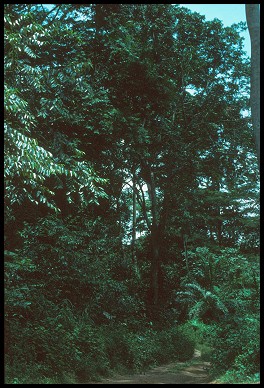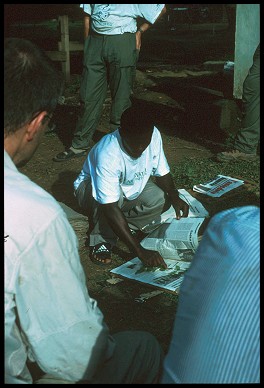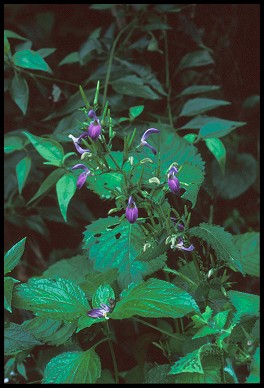Cameroon Projects: Mefou Proposed National Park
The Proposed Mefou National Park, Central Province, Cameroon
|
The proposed Mefou National Park lies near the capital city, Yaoundé. It is largely lowland forest below 600 m alt. with several hills and rivers. Parts in the south around the village of Ndanan I, where CWAF's base camp is placed, are used to rehabilitate gorillas, chimpanzees and other primates captured from poachers by officers of the Ministry of the Environment & Forests (MINEF). No previous botanical inventory work had been conducted in the area, so far as is known. The first expedition into this area took place in October 2002.
Dave Kruger (Earthwatch volunteer) at the gorilla enclosures, Mefou. |

The forest at Mefou, along the track from Ndanan I to II. |
Although a relatively small area, a number of different vegetation type occur at Mefou. Most of the proposed park area that was seen comprises of farmland/farmbush. These areas are believed to have been logged and then to have been converted to Cocoa and Cassava farms which are still very much apparent. On the route due south of Ndanan I, open Raphia swamp and cyperaceae meadows are encountered. However, north of this village is semi-deciduous forest, rich in timber species. Near the village of Ndanan II there is inundated fresh water swamp forest dominated by Gilbertiodendron dewevrei and Nauclea amongst others. In the lower lying areas is evergreen forest, a habitat that is probably the most species diverse in the park.
| Kew projects
Working together with the Herbier National Camerounais (HNC-IRAD) and CWAF (Cameroon Wildlife Aid Fund, supported by Bristol zoo), and in part sponsored by Earthwatch, the objectives of the project are:
|

Edmondo Njume, Equipment Manager on the Cameroon Rainforest Earthwatch expeditions, demonstrating plant pressing techniques to the Earthwatch volunteers. |
| New
discoveries
Two rare, and very distinctive species were identified; both are potential Red Data Species and therefore are potential priorities for conservation. Neither of these species had been seen alive by any of the botanists concerned, causing considerable interest:
|
 |
 |
| Brillantasia owariensis (Acanthaceae) growing along the track from Ndanan I to II, Mefou |
Collecting a specimen of Cucurbitaceae near abandoned chimpanzee enclosure, Mefou |
|
Bibliography Carroll, J. B., Gage, M., Hurst, L. & Maddison, N. (2003). Bristol Zoo Gardens supporting primates in Cameroon: a partnership with Cameroon Wildlife Aid Fund. International Zoo News 50(1): 21-26. Wortley, A. (2003). Hunting Thomandersia: observations of an apprentice plant collector. Oxford Plant Systematics 10: 8-9. |


